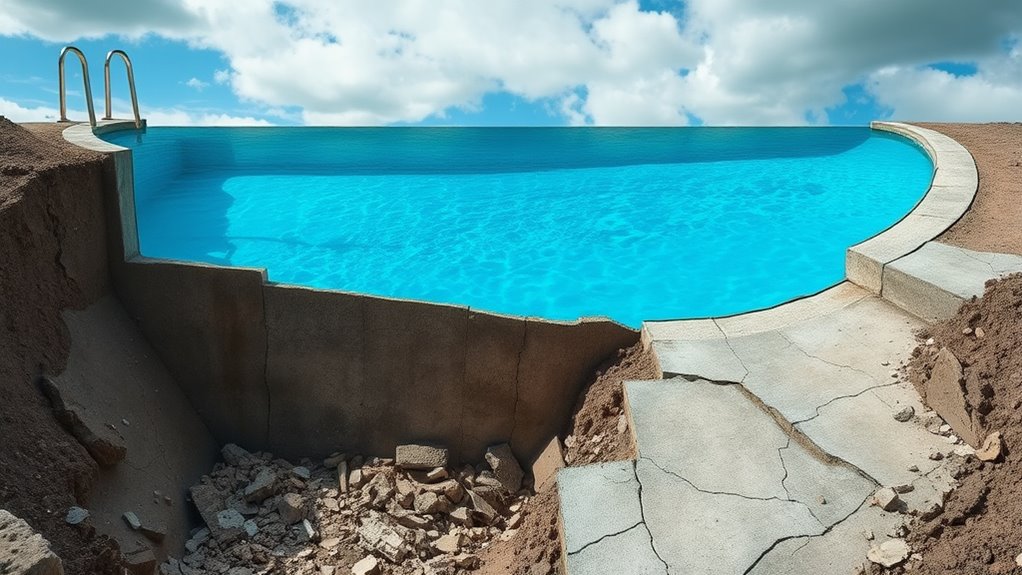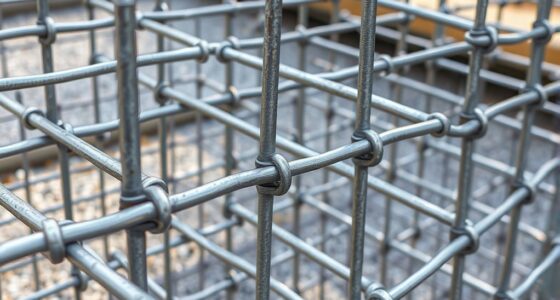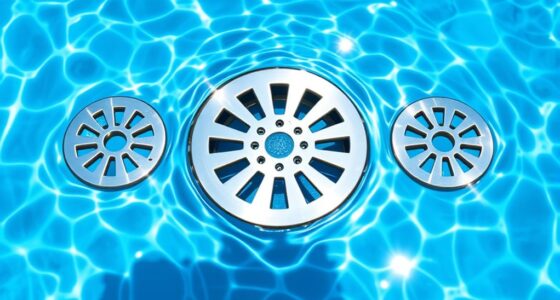When you drain your pool, you remove the water that balances hydrostatic pressure from groundwater surrounding it. Without this water, the ground’s pressure can push against the empty shell, risking cracks, warping, or even structural collapse. Groundwater can exert significant force, especially if water tables are high. To avoid disaster, you need to understand how hydrostatic pressure works and take precautions. Keep exploring to discover essential techniques and safety tips that can protect your pool from these hidden dangers.
Key Takeaways
- Empty pools lose water pressure support, allowing external hydrostatic pressure from groundwater to cause wall collapse.
- Draining too quickly or unevenly can create stress, cracks, or structural failure due to sudden pressure shifts.
- External groundwater exerts lateral force on the pool shell, risking damage if not properly managed before drainage.
- Uncontrolled drainage may lead to soil instability and ground movement, further damaging the pool structure.
- Proper, gradual draining and groundwater monitoring are essential to prevent structural disasters during pool maintenance.
Understanding Hydrostatic Pressure and Its Impact on Pools
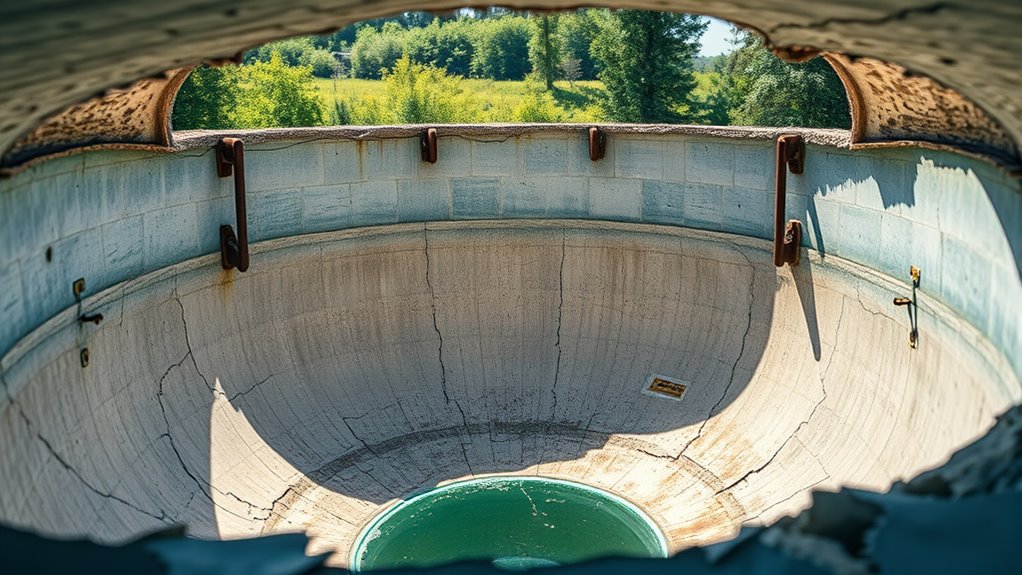
Understanding hydrostatic pressure is essential if you want your pool to stay safe and in good condition. When your pool is filled with water, the pressure exerted by the water increases considerably with depth. This force pushes against the pool walls and floor, helping to keep the structure stable. If the water level drops dramatically, the pressure decreases, leaving the pool walls vulnerable to collapse or shifting. This is especially dangerous if the pool is empty or nearly empty because the ground’s soil can exert lateral pressure on the structure, causing cracks or even a sudden failure. Recognizing how hydrostatic pressure works helps you prevent damage, maintain proper water levels, and avoid costly repairs or dangerous accidents. Proper gear shifting techniques on your gravel bike can also help you manage terrain more effectively, reducing stress on your pool or structure during maintenance or repair activities.
How Water Beneath the Ground Exerts Force on Your Pool Structure

When a pool is built underground, the earth surrounding it contains water that exerts additional pressure on the structure. This hydrostatic pressure pushes inward from all sides, increasing as the water level outside rises. If you don’t account for this force, your pool walls may crack or collapse. It’s essential to understand that the pressure depends on the depth of the groundwater and soil conditions. Proper drainage and waterproofing help manage this force. Ignoring these factors can lead to structural failure, especially during heavy rains or groundwater fluctuations. Understanding the soil type around your pool can help predict how pressure will distribute and affect the structure.
Risks Associated With Draining a Pool Without Proper Precautions
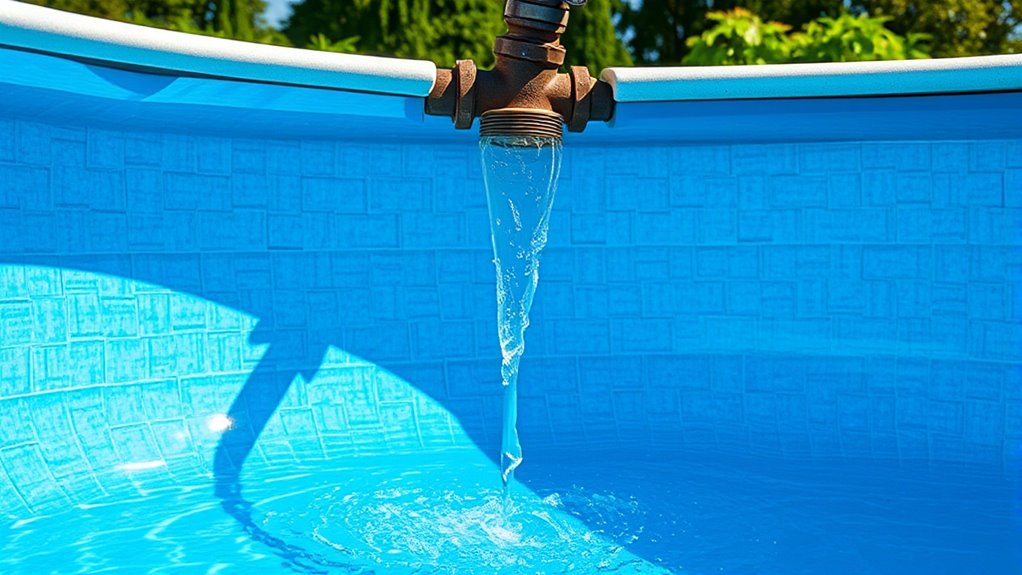
If you drain your pool without proper precautions, you risk causing structural damage to the surrounding area. Uncontrolled water flow can lead to unexpected shifts or collapses, putting your property at risk. Understanding these dangers helps you avoid costly repairs and safety hazards. Additionally, improper draining can create hazardous conditions such as hydrostatic pressure buildup, which can cause the pool shell or surrounding structures to crack or fail.
Structural Damage Risks
Draining a pool without taking proper precautions can lead to significant structural damage. When the water weight is suddenly removed, the pool walls and foundation may struggle to support the remaining structure. This can cause cracks, warping, or even collapse. Without proper support or gradual draining, the pressure distribution becomes uneven, stressing the pool’s materials.
Be aware of these risks:
- Cracks in walls and floors
- Collapsing or buckling of the pool shell
- Damage to surrounding landscaping
- Shifting or settling of the foundation
- Increased risk of leaks and water infiltration
Understanding these dangers emphasizes the importance of a controlled approach. Failing to do so can result in costly repairs and possible safety hazards. Proper planning is essential to protect your property’s integrity.
Unpredictable Water Flow
Without proper precautions, the water flow during pool draining can become unpredictable, posing serious risks. Sudden shifts or surges can occur if the drain or outlet becomes obstructed or if the drainage process isn’t carefully managed. Water may flow unevenly, causing unexpected pressure points that could crack the pool or damage surrounding structures. If you’re not vigilant, rapid emptying can lead to water rushing into areas that can’t handle the volume, flooding nearby property or destabilizing the ground. Additionally, unanticipated flow patterns might cause debris or sediment to clog drainage systems, slowing or halting the process. Proper planning and understanding of water flow dynamics, such as pressure management, are essential to prevent these hazards. To prevent these hazards, you need a clear plan, controlled drainage, and constant monitoring. Proper precautions guarantee predictable flow, keeping you safe and minimizing damage.
Signs That Your Pool Is Being Affected by Hydrostatic Pressure
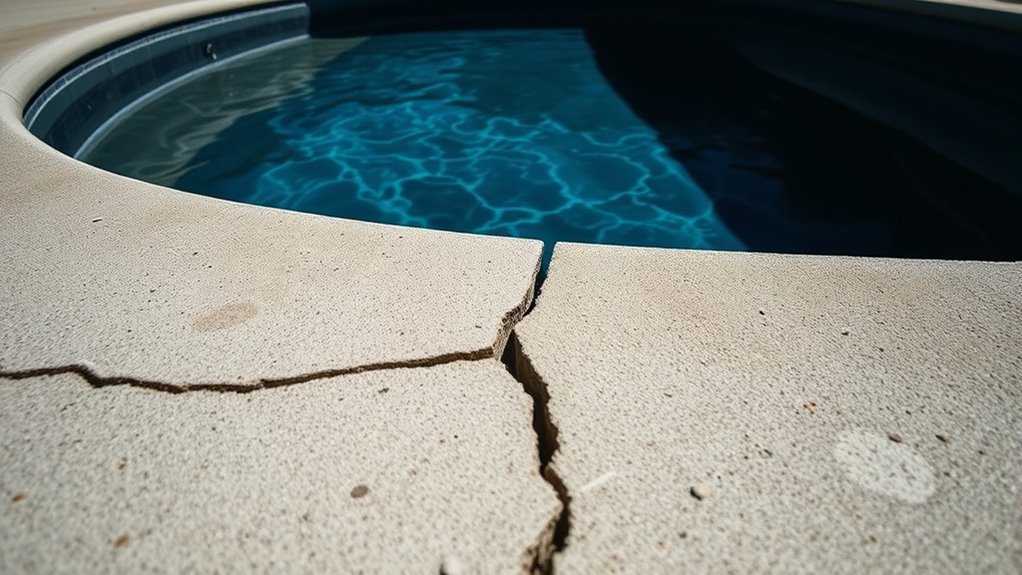
You may notice some telltale signs that hydrostatic pressure is impacting your pool. These signs indicate that the water beneath the surface is exerting force on the structure, which can cause damage if not addressed. Look out for the following:
- Uneven or cracked pool walls and floors
- Gaps or separation between pool components
- Warping or bulging of the pool shell
- Water loss or unexplained drops in water level
- Difficulties in opening or closing access points
Recognizing these signs early can help you prevent costly repairs and potential disasters. Hydrostatic pressure can be subtle at first, but paying close attention to these indicators allows you to take timely action before structural integrity is compromised. Additionally, understanding fabric decorating markers can assist in labeling or marking areas of concern for maintenance.
Techniques to Safely Drain a Pool and Manage Hydrostatic Forces

When signs of hydrostatic pressure threaten your pool’s stability, safely draining the water becomes a necessary step to prevent further damage. Start by consulting a professional to assess the situation and determine the safest method. Use a controlled, gradual drain, often through dedicated drain outlets or installed valves, to avoid sudden shifts in pressure. Installing relief vents or hydrostatic valves can help release pressure safely during the process. Avoid draining the pool completely unless absolutely necessary; partial draining reduces stress on the structure. Always monitor the water level closely and stop draining if you notice any signs of shifting or cracking. Remember, rushing the process or ignoring proper procedures can lead to severe damage or failure. When in doubt, seek expert assistance to manage hydrostatic forces effectively. Understanding the risks of structural damage is crucial to ensuring a safe and successful drainage.
Preventative Measures to Protect Your Pool From Groundwater Pressure
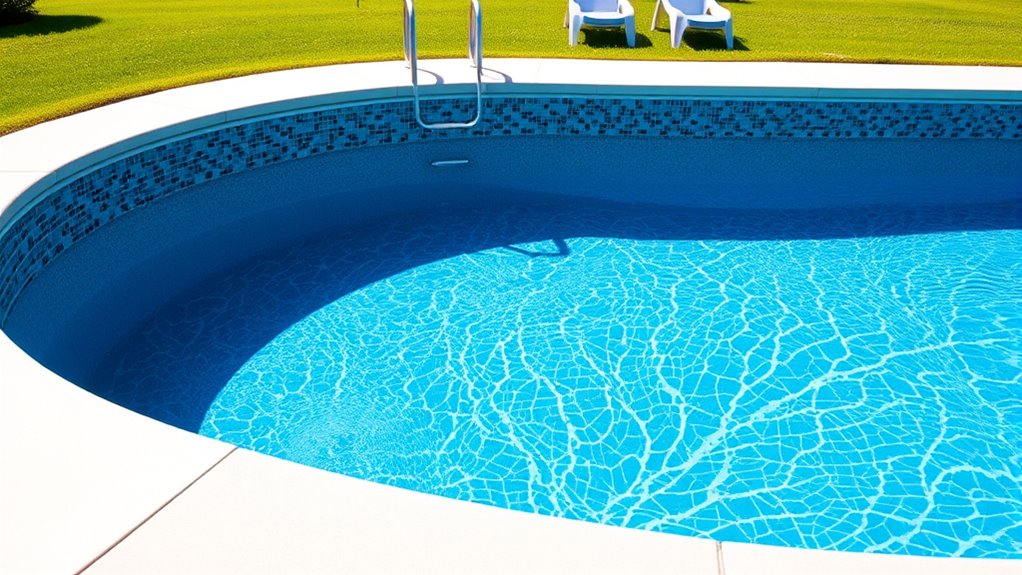
Groundwater pressure can pose a serious threat to your pool’s stability if left unchecked. To prevent damage, you should implement proactive measures that minimize hydrostatic risks. First, install a hydrostatic relief valve to automatically release pressure if it becomes too great. Secondly, maintain proper drainage around your pool to prevent water accumulation. Regularly inspect and repair cracks or leaks that could allow groundwater intrusion. Building a reinforced, watertight pool shell helps resist external pressure. Additionally, consider installing a sump system to divert groundwater away from the pool area. These precautions can markedly reduce the likelihood of structural failure. Proper color accuracy in your pool’s construction materials can also help in detecting early signs of stress or damage. By staying vigilant and maintaining your pool’s integrity, you protect your investment and avoid costly repairs caused by hydrostatic pressure.
What to Do If Your Pool Has Suffered Damage Due to Hydrostatic Pressure
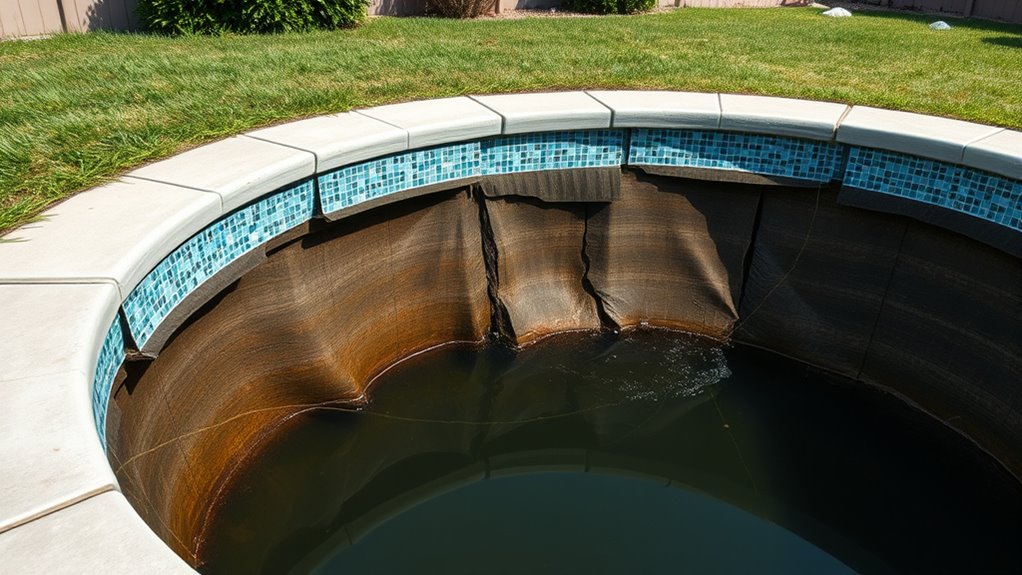
If hydrostatic pressure has caused damage to your pool, acting quickly is essential to prevent further deterioration. First, drain the surrounding groundwater carefully using a sump pump or professional help. Avoid draining the pool completely, as this can worsen structural issues. Once the water is lowered, inspect the damage thoroughly. Cracks, shifted panels, or a bowed structure indicate serious problems. Contact a professional pool repair specialist immediately to assess and repair the damage properly. Do not attempt to fix major structural issues yourself, as improper repairs can lead to more costly damage. Regularly monitor the site for signs of ongoing groundwater pressure. Understanding sleep impacts on decision-making can help you stay alert to potential risks during repairs. Taking swift action minimizes repair costs and helps restore your pool’s safety and integrity.
Frequently Asked Questions
How Can I Tell if My Pool Is Experiencing Hydrostatic Pressure?
You can tell if your pool is experiencing hydrostatic pressure by noticing any unusual movement or shifting of the pool walls or floor, especially after heavy rain or groundwater changes. If the pool suddenly rises or feels uneven when filled, it’s a sign of pressure build-up. Also, cracks or leaks might develop. It’s best to consult a professional if you suspect hydrostatic pressure to prevent potential damage.
What Are the Long-Term Effects of Hydrostatic Pressure on Pool Materials?
Imagine your pool’s materials as a fragile heart, strained by relentless pressure. Long-term hydrostatic pressure weakens your pool’s structure, causing cracks, leaks, and even collapse over time. It can corrode liners, deform shells, and undermine the integrity of concrete. If ignored, these effects lead to costly repairs or total replacement. To protect your investment, address hydrostatic issues promptly, ensuring your pool remains safe and durable for years to come.
Are There Specific Seasons When Hydrostatic Pressure Risks Are Higher?
You’re more likely to face hydrostatic pressure risks during heavy rain or rapid temperature changes, especially in spring and fall. During these seasons, groundwater levels rise, increasing pressure on your pool’s structure. If you’re planning to empty your pool, avoid doing so during or right after these periods. Instead, wait for dry, stable conditions to minimize the risk of structural damage caused by rising groundwater.
Can Hydrostatic Pressure Damage Be Detected Before Visible Signs Appear?
Like a hidden iceberg beneath the surface, hydrostatic pressure damage can lurk unseen. You can detect it early through professional inspections, which reveal subtle cracks or shifts in your pool’s structure before they turn into visible problems. Regular maintenance, including pressure tests and structural assessments, helps catch issues early. Don’t wait for signs; proactive detection saves you from costly repairs and potential disaster down the line.
What Professional Services Are Recommended for Hydrostatic Pressure Assessments?
You should hire a professional geotechnical engineer or a specialized foundation inspector for hydrostatic pressure assessments. These experts use advanced tools like piezometers and pressure sensors to measure soil and water pressures accurately. They can evaluate your site’s conditions, identify potential risks, and recommend appropriate solutions before any visible damage occurs. Relying on trained professionals helps prevent costly structural failures and guarantees your property’s safety.
Conclusion
Think of your pool as a fragile boat, resting peacefully on a vast, unseen ocean of groundwater. When you drain it without caution, that silent tide rushes in, threatening to sink your safe haven. By respecting the hidden forces beneath, you protect your retreat from disaster. Remember, understanding hydrostatic pressure isn’t just about avoiding damage—it’s about safeguarding your sanctuary, ensuring it remains a symbol of relaxation rather than a reminder of overlooked dangers.
